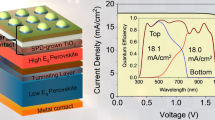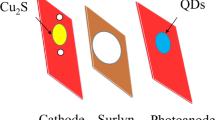Abstract
CdS/CIGS mono junction is a potential approach to produce an ultra-high efficiency and low-cost all-thin-film solar cell. In this article, a conventional mono junction with a maximum efficiency of 22.56% at 4 µm of CIGS thickness is developed and optimized. We have combined this cell with Si/MoOx (20 nm) (Si polycrystalline) as a tandem solar cell based on CIGS thin films {(Al-ZnO/CdS/CIGS/Si/MoOx HTL/Mo)} to enhance the CIGS solar cell’s efficiency. The new solar cell’s characteristic was analyzed by employing SCAPS-1D. From the presented results, it turns out that, the findings of the studied (Al-ZnO/CdS/CIGS/Mo) characteristics are in excellent accordance with those obtained by experimental methods. The aim of the research work was the study of the Si/MoOx layer's influence on the efficiency of the proposed CIGS-based hetero-junction solar cell. A significant efficiency of 28.08% has been obtained for the studied solar cell with 1 µm thick of CIGS, 1 µm and 20 nm of Si, and MoOx layers respectively. All of these findings indicate that CIGS is compatible with Si/MoOx adjoining layers, ensuring good contact and charge transmission.
Similar content being viewed by others
Data Availability
The datasets generated and analyzed during the current study are available from the corresponding author on reasonable request.
All data generated and analyzed in this original work research are included in this published paper as tables, figures, and detailed parameters with their reference’s sources.
References
Dharmadasa IM (2018) Advances in Thin-Film Solar Cells, 2nd edn. Jenny Stanford Publishing, Boca Raton
Copper Indium Gallium Diselenide Solar Cells. https://www.nrel.gov/pv/copper-indium-gallium-diselenide-solar-cells.html. Accessed 9 Aug 2022
Mostefaoui M, Mazari H, Khelifi S et al (2015) Simulation of high efficiency CIGS solar cells with SCAPS-1D software. Energy Procedia 74:736–744
Yamada A, Matsubara K, Sakurai K et al (2004) Effect of band offset on the open circuit voltage of heterojunction CuIn1−xGaxSe2 solar cells. Appl Phys Lett 85:5607–5609. https://doi.org/10.1063/1.1831566
Rusu M, Kodalle T, Choubrac L et al (2021) Electronic Structure of the CdS/Cu (In, Ga) Se2 Interface of KF-and RbF-Treated Samples by Kelvin Probe and Photoelectron Yield Spectroscopy. ACS Appl Mater Interfaces 13:7745–7755
Belarbi F, Rahal W, Rached D et al (2020) A comparative study of different buffer layers for CZTS solar cell using Scaps-1D simulation program. Optik 216:164743. https://doi.org/10.1016/j.ijleo.2020.164743
Bouich A, Ullah S, Ullah H et al (2020) Electrodeposited CdZnS/CdS/CIGS/Mo: Characterization and Solar Cell Performance. JOM 72:615–620. https://doi.org/10.1007/s11837-019-03951-5
Chen C-C, Qi X, Tsai M-G et al (2013) Low-temperature growth of Na doped CIGS films on flexible polymer substrates by pulsed laser ablation from a Na containing target. Surf Coat Technol 231:209–213. https://doi.org/10.1016/j.surfcoat.2012.06.065
Jung S, Ahn S, Yun JH et al (2010) Effects of Ga contents on properties of CIGS thin films and solar cells fabricated by co-evaporation technique. Curr Appl Phys 10:990–996. https://doi.org/10.1016/j.cap.2009.11.082
Mousavi SH, Müller TS, de Oliveira PW (2012) Synthesis of colloidal nanoscaled copper–indium–gallium–selenide (CIGS) particles for photovoltaic applications. J Colloid Interface Sci 382:48–52. https://doi.org/10.1016/j.jcis.2012.05.030
Khadir A (2020) Simulation of effects of defects and layers thickness on the performance of CIGS solar cells. Acta Phys Pol, A 137:1128–1134
Peace B, Claypoole J, Sun N et al (2016) Characterization of Cu (In, Ga) Se2 (CIGS) films with varying gallium ratios. J Alloy Compd 657:873–877
Prasad R, Pal R, Singh UP (2022) Performance optimization of single graded CIGS absorber and buffer layers for high efficiency: A numerical approach. Superlattices Microstruct 161:107094
Ballabio M, Fuertes Marrón D, Barreau N et al (2020) Composition-Dependent Passivation Efficiency at the CdS/CuIn1-xGaxSe2 Interface. Adv Mater 32:1907763
Ahmad F, Anderson TH, Monk PB, Lakhtakia A (2019) Efficiency enhancement of ultrathin CIGS solar cells by optimal bandgap grading. Appl Opt 58:6067–6078
Shockley W, Queisser HJ (1961) Detailed balance limit of efficiency of p-n junction solar cells. J Appl Phys 32:510–519
Park JC, Al-Jassim M, Shin SW et al (2019) Comprehensive characterization of CIGS absorber layers grown by one-step sputtering process. Ceram Int 45:4424–4430
Badgujar AC, Dusane RO, Dhage SR (2020) Pulsed laser annealing of spray casted Cu (In, Ga) Se2 nanocrystal thin films for solar cell application. Sol Energy 199:47–54
Huang C-H, Chuang W-J, Lin C-P et al (2018) Deposition technologies of high-efficiency CIGS solar cells: development of two-step and co-evaporation processes. Curr Comput-Aided Drug Des 8:296
Jackson P, Hariskos D, Lotter E et al (2011) New world record efficiency for Cu(In, Ga)Se2 thin-film solar cells beyond 20%. Prog Photovoltaics Res Appl 19:894–897. https://doi.org/10.1002/pip.1078
Lin L, Ravindra NM (2020) CIGS and perovskite solar cells–an overview. Emerging Materials Research 9:812–824
Abdelkadir AA, Oublal E, Sahal M, Gibaud A (2022) Numerical simulation and optimization of n-Al-ZnO/n-CdS/p-CZTSe/p-NiO (HTL)/Mo solar cell System using SCAPS-1D. Results in Optics 100257
Oublal E, Sahal M, Abdelkadir AA (2022) New theoretical analysis of a novel hetero-junction SnS/CdS solar cell with homo-junction P–P+ in the rear face-numerical approach. Current Applied Physics
New Pathway Emerges To Improve Polycrystalline Thin-Film Solar Cell Performance. https://www.nrel.gov/news/program/2021/new-pathway-emerges-to-improve-polycrystalline-thin-film-solar-cell-performance.html. Accessed 14 Aug 2022
Ramanathan K, Contreras MA, Perkins CL et al (2003) Properties of 19.2% efficiency ZnO/CdS/CuInGaSe2 thin-film solar cells. Prog Photovoltaics Res Appl 11:225–230
Yamada A, Matsubara K, Sakurai K et al (2005) Built-in Potential and Open Circuit Voltage of Heterojunction CuIn1-xGaxSe2 Solar Cells. MRS Online Proc Libr 865:519. https://doi.org/10.1557/PROC-865-F5.19
Vermang B, Wätjen JT, Fjällström V et al (2014) Employing Si solar cell technology to increase efficiency of ultra-thin Cu(In, Ga)Se2 solar cells. Prog Photovoltaics Res Appl 22:1023–1029. https://doi.org/10.1002/pip.2527
Irfan I, Lin H, **a W et al (2012) The effect of MoOx inter-layer on thin film CdTe/CdS solar cell. Sol Energy Mater Sol Cells 105:86–89. https://doi.org/10.1016/j.solmat.2012.04.006
Lin H, **a W, Wu HN, Tang CW (2010) CdS/CdTe solar cells with MoOx as back contact buffers. Appl Phys Lett 97:123504. https://doi.org/10.1063/1.3489414
Paudel NR, Compaan AD, Yan Y (2013) Sputtered CdS/CdTe solar cells with MoO3−x/Au back contacts. Sol Energy Mater Sol Cells 113:26–30. https://doi.org/10.1016/j.solmat.2013.01.041
Yang R, Wang D, Jeng M et al (2016) Stable CdTe thin film solar cells with a MoOx back-contact buffer layer. Prog Photovoltaics Res Appl 24:59–65. https://doi.org/10.1002/pip.2645
Battaglia C, de Nicolás SM, De Wolf S et al (2014) Silicon heterojunction solar cell with passivated hole selective MoOx contact. Appl Phys Lett 104:113902. https://doi.org/10.1063/1.4868880
Bullock J, Cuevas A, Allen T, Battaglia C (2014) Molybdenum oxide MoOx: A versatile hole contact for silicon solar cells. Appl Phys Lett 105:232109. https://doi.org/10.1063/1.4903467
Burgelman M, Nollet P, Degrave S (2000) Modelling polycrystalline semiconductor solar cells. Thin Solid Films 361:527–532
Heriche H, Rouabah Z, Bouarissa N (2017) New ultra thin CIGS structure solar cells using SCAPS simulation program. Int J Hydrogen Energy 42:9524–9532
Liu J, Chen W, Feng X (2018) Numerical simulation of ultra-thin CdTe solar cells with a buffer layer of MoOx in the backwall configuration. Chin J Phys 56:1826–1833
Al-Hattab M, Khenfouch M, Bajjou O et al (2021) Numerical simulation of a new heterostructure CIGS/GaSe solar cell system using SCAPS-1D software. Sol Energy 227:13–22
Khoshsirat N, Md Yunus NA (2013) Numerical simulation of CIGS thin film solar cells using SCAPS-1D. In: 2013 IEEE Conference on Sustainable Utilization and Development in Engineering and Technology (CSUDET). pp 63–67
Khoshsirat N, Md Yunus NA, Hamidon MN et al (2015) Analysis of absorber layer properties effect on CIGS solar cell performance using SCAPS. Optik 126:681–686. https://doi.org/10.1016/j.ijleo.2015.02.037
Lundberg O, Bodegård M, Malmström J, Stolt L (2003) Influence of the Cu (In, Ga) Se2 thickness and Ga grading on solar cell performance. Prog Photovoltaics Res Appl 11:77–88
Shen H, Duong T, Peng J et al (2018) Mechanically-stacked perovskite/CIGS tandem solar cells with efficiency of 23.9% and reduced oxygen sensitivity. Energy Environ Sci 11:394–406. https://doi.org/10.1039/C7EE02627G
Bailie CD, Christoforo MG, Mailoa JP et al (2015) Semi-transparent perovskite solar cells for tandems with silicon and CIGS. Energy Environ Sci 8:956–963. https://doi.org/10.1039/C4EE03322A
Touafek N, Mahamadi R (2014) Back surface recombination effect on the ultra-thin CIGS solar cells by SCAPS. International Journal of Renewable Energy Research 4:958–964
Todorov T, Gershon T, Gunawan O et al (2015) Monolithic perovskite-CIGS tandem solar cells via in situ band gap engineering. Adv Energy Mater 5:1500799
Chelvanathan P, Hossain MI, Amin N (2010) Performance analysis of copper–indium–gallium–diselenide (CIGS) solar cells with various buffer layers by SCAPS. Curr Appl Phys 10:S387–S391. https://doi.org/10.1016/j.cap.2010.02.018
Minemoto T, Matsui T, Takakura H et al (2001) Theoretical analysis of the effect of conduction band offset of window/CIS layers on performance of CIS solar cells using device simulation. Sol Energy Mater Sol Cells 67:83–88. https://doi.org/10.1016/S0927-0248(00)00266-X
Repins I, Contreras MA, Egaas B et al (2008) 19· 9%-efficient ZnO/CdS/CuInGaSe2 solar cell with 81· 2% fill factor. Prog Photovoltaics Res Appl 16:235–239
Benabbas S, Rouabah Z, Heriche H, Chelali N-E (2016) A numerical study of high efficiency ultra-thin CdS/CIGS solar cells. Afr J Sci Technol Innov Dev 8:340–342. https://doi.org/10.1080/20421338.2015.1118929
Hadjab M, Wagner J-M, Bouzid F et al (2022) A numerical optimization study of CdS and Mg0. 125Zn0. 875O buffer layers in CIGS-based solar cells using wx AMPS-1D package. Int J Model Simul 42:179–191
Barman B, Kalita PK (2021) Influence of back surface field layer on enhancing the efficiency of CIGS solar cell. Sol Energy 216:329–337
Acknowledgements
All authors gratefully thank Dr. Marc Burgelman of Ghent University in Belgium for supplying the SCAPS 1-D simulator program and respectfully thank everyone who contributed to this scientific work.
Funding
The authors declare that no funds, grants, or other support were received during the preparation of this manuscript.
Author information
Authors and Affiliations
Contributions
The study's conception and design were contributed to by all of the authors. Material preparation, data collecting, and analysis were provided by Ph. D students Abdelaziz AIT ABDELKADIR and Essaadia OUBLAL, as well as Professor Mustapha SAHAL, Professor Abdelhadi KOTRI, Professor Mohamed HANGOURE, Professor Bernabé Mari Soucase, and Professor Naveen KUMAR.
Abdelaziz AIT ABDELKADIR and Professor Mustapha SAHAL wrote the first draft of the text, while other writers provided feedback on the earlier manuscript. The final document was read and approved by all of the writers.
Corresponding authors
Ethics declarations
Consent to Participate
The study's conception and design were contributed to by all of the authors. Furthermore, all the authors have approved the manuscript and agree to submit it to your journal.
Consent for Publication
The paper has been approved by all of the authors, and they have agreed to submit it to your esteemed journal.
Competing Interests
The authors have no relevant financial or non-financial interests to disclose.
Conflicts of Interest
The authors report that they have no conflicts of interest to disclose.
Research Involving Human Participants and/or Animals
Not applicable to this research work.
Informed Consent
All authors have approved the manuscript and agree to submit it to your esteemed journal.
Additional information
Publisher's Note
Springer Nature remains neutral with regard to jurisdictional claims in published maps and institutional affiliations.
Rights and permissions
Springer Nature or its licensor holds exclusive rights to this article under a publishing agreement with the author(s) or other rightsholder(s); author self-archiving of the accepted manuscript version of this article is solely governed by the terms of such publishing agreement and applicable law.
About this article
Cite this article
Ait Abdelkadir, A., Oublal, E., Sahal, M. et al. Numerical Simulation and Optimization of n-Al-ZnO/n-CdS/p-CIGS/p-Si/p-MoOx/Mo Tandem Solar Cell. Silicon 15, 2125–2135 (2023). https://doi.org/10.1007/s12633-022-02144-1
Received:
Accepted:
Published:
Issue Date:
DOI: https://doi.org/10.1007/s12633-022-02144-1




